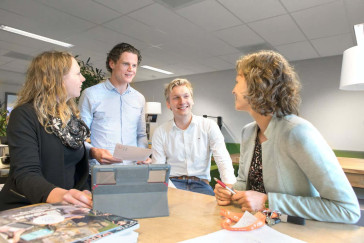Due to the changing technological possibilities of services, the demands that society places on the level of service provided by the Dutch Central Government (DCG) are changing rapidly. To accommodate this, the Dutch government is improving its processes in such a way that they become more agile and are continuously improved. However, the DCG struggles with the implementation of improvement tools that can support this. The research described in this paper aims to deliver key factors that influence the adoption of tools that improve the agile way of working and continuous improvement at the DCG. Therefore, a literature review has been conducted, from which 24 factors have been derived. Subsequently, 9 semi structured interviews have been conducted to emphasize the perspective of employees at the DCG. In total, 7 key factors have been derived from the interviews. The interviewees consisted of both employees from departments who already worked with tools to improve agile working and continuous improvement as well as employees from departments who haven’t used such tools yet. An important insight based on this research is that the aims, way of working and scope of the improvement tools must be clear for all the involved co-workers
MULTIFILE

Purpose: To deal with an increasingly competitive environment, organizations are combining continuous improvement (CI) practices with digitalization to accrue their benefits on operational performance and achieve operational excellence. The purpose of this study was to identify the enablers and inhibitors of digitalization as part of CI projects. Design/methodology/approach: A mixed-methods sequential explanatory research design consisting of an online survey and semi-structured interviews was used to examine how digitalization technologies have been incorporated by organizations in their CI projects. Findings: Key enablers of digitalization were found to be leadership capabilities, strategic direction, stakeholder involvement, system compatibility, data quality and giving employees room to experiment. Knowledge of digitalization was found to affect all these enablers. Research limitations/implications: The empirical findings are based on a nonprobability sample of Dutch CI practitioners, limiting their generalizability. Practical implications: The empirical findings highlight the need for organizations to adopt a structured approach to implementing digitalization as part of their CI projects, starting by ensuring that the necessary knowledge and skills are either present or accessible to the organization. Originality/value: The empirical findings show that enablers of digitalization in the context of CI are strongly interlinked, and thus require a holistic approach.
LINK
In pursuit of competitive advantage in an increasingly globalized and complex environment, organizations are turning to continuous improvement and digitalization to achieve operational excellence. Viewed through the lens of Dynamic Capabilities Theory, the similarities complementarities, and synergies of continuous improvement capability and data analytic capability are examined. Bridging the gap between theory and practice, continuous improvement routines and practices that can be harnessed to accelerate the implementation of data analytical capability are identified. These include Hoshin Kanri to link digitalization projects to organizational strategic, training to develop organizational knowledge of digitalization, problem solving teams to break knowledge silos, and the use of PDCA-type processes for adopting and monitoring the performance of digital technologies.
LINK
The increasing amount of electronic waste (e-waste) urgently requires the use of innovative solutions within the circular economy models in this industry. Sorting of e-waste in a proper manner are essential for the recovery of valuable materials and minimizing environmental problems. The conventional e-waste sorting models are time-consuming processes, which involve laborious manual classification of complex and diverse electronic components. Moreover, the sector is lacking in skilled labor, thus making automation in sorting procedures is an urgent necessity. The project “AdapSort: Adaptive AI for Sorting E-Waste” aims to develop an adaptable AI-based system for optimal and efficient e-waste sorting. The project combines deep learning object detection algorithms with open-world vision-language models to enable adaptive AI models that incorporate operator feedback as part of a continuous learning process. The project initiates with problem analysis, including use case definition, requirement specification, and collection of labeled image data. AI models will be trained and deployed on edge devices for real-time sorting and scalability. Then, the feasibility of developing adaptive AI models that capture the state-of-the-art open-world vision-language models will be investigated. The human-in-the-loop learning is an important feature of this phase, wherein the user is enabled to provide ongoing feedback about how to refine the model further. An interface will be constructed to enable human intervention to facilitate real-time improvement of classification accuracy and sorting of different items. Finally, the project will deliver a proof of concept for the AI-based sorter, validated through selected use cases in collaboration with industrial partners. By integrating AI with human feedback, this project aims to facilitate e-waste management and serve as a foundation for larger projects.
In dit project wordt gekeken naar de validatie van een procesverbeteringstool.

In dit project wordt gekeken naar de validatie van een procesverbeteringstool.Doel De belastingdienst heeft een tool ontwikkeld met als doel de samenhang tussen Business en IT te verbeteren en een proces van continu verbeteren op te starten. Deze tool wil de belastingdienst objectief te evalueren. Resultaten Dit project leidt tot de volgende resultaten: Een validatierapport Een verbeterplan Een wetenschappelijk artikel Looptijd 01 oktober 2021 - 31 december 2022 Aanpak Binnen dit onderzoek wordt gebruik gemaakt van de volgende onderzoeksmethoden: Focusgroepen Literatuuronderzoek Workshops Meedoen in dit onderzoek? Als je onderzoek wil doen naar tools in het werkveld van Agile werken, Business IT alignement of continu verbeteren, neem dan contact op met Paul Morsch.